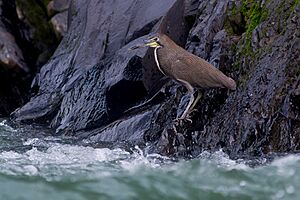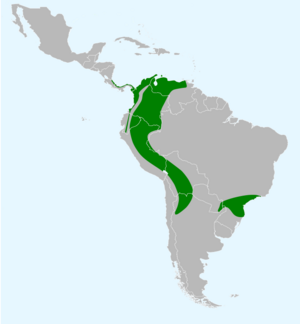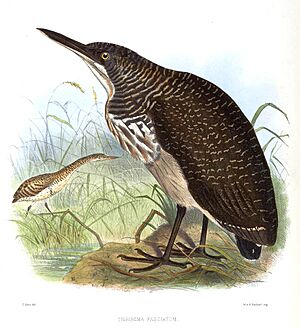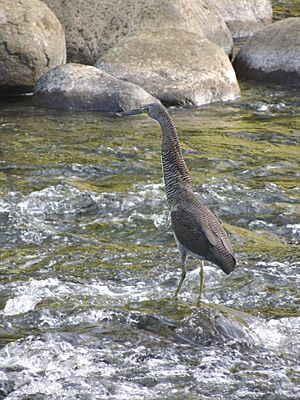Fasciated tiger heron facts for kids
Quick facts for kids Fasciated tiger heron |
|
|---|---|
 |
|
| Conservation status | |
| Scientific classification | |
| Genus: |
Tigrisoma
|
| Species: |
fasciatum
|
 |
|
| Range for T. fasciatum | |
The fasciated tiger heron (Tigrisoma fasciatum) is a type of heron bird. It belongs to the Ardeidae family. You can find this bird in parts of southern Central America and northern and central South America. It likes to live near rivers.
In 1988, experts thought the fasciated tiger heron was "Near Threatened" (meaning it might become endangered soon). But by 2004, they changed its status to "Least Concern" because its numbers were doing better.
Contents
About the Fasciated Tiger Heron
Scientists group living things into categories. This helps us understand how they are related. The fasciated tiger heron is one of three species in the Tigrisoma group.
It was first described in 1825 by a scientist named George Such. He called it Ardea fasciata back then. Sometimes, people used to think it was just a type of rufescent tiger heron.
Types of Fasciated Tiger Herons
There are three different types, or subspecies, of the fasciated tiger heron:
- T. f. fasciatum: This type lives in the very northeastern part of Argentina and southeastern Brazil. George Such described it in 1825.
- T. f. pallescens: This one was described by Claes C. Olrog in 1950. It lives in northwestern Argentina.
- T. f. salmoni: This is the most common type. It was described by Philip Lutley Sclater and Osbert Salvin in 1875. You can find it in many places, including Costa Rica, Panama, Colombia, Ecuador, Peru, Bolivia, and northern Venezuela.
What Does Its Name Mean?
The scientific name Tigrisoma comes from two Greek words. Tigris means "tiger," and somā means "body." The second part of its name, fasciatum, is a Latin word meaning "banded." Both the scientific name and the common name "fasciated tiger heron" refer to the thin stripes on the bird's upper body. These stripes look a bit like tiger stripes!
What Does the Fasciated Tiger Heron Look Like?
The fasciated tiger heron is the smallest of the three tiger herons. It is about 23 to 25 inches (58 to 64 cm) long.
Adult birds have a black top of the head and gray sides of the face. Their neck and upper body are black with light, thin stripes. Their belly is grayish-brown, and their sides are gray.
Its beak is shorter and thicker than other tiger herons. The top part of its beak is black, and the bottom part is yellowish-green. Its eyes are yellow.
Where Do Fasciated Tiger Herons Live?
You can usually find the fasciated tiger heron in hilly areas. They like rocky, fast-moving streams. Their home range stretches from Costa Rica all the way through northwestern Argentina, southeastern Brazil, and Guyana. Sometimes, one might even be seen in Nicaragua.
These birds can live from sea level up to about 2,400 feet (730 meters) high. However, they usually prefer higher places than the rufescent tiger heron when both species live in the same area.
How Do Fasciated Tiger Herons Behave?
The fasciated tiger heron usually lives alone. But sometimes, several birds might gather a few hundred yards apart in good fishing spots.
What Do Fasciated Tiger Herons Eat?
This heron hunts along rivers. It stands on the shore or on rocks in the water. It stretches its neck out, waiting for prey. It mainly eats fish, which it catches by quickly stabbing with its beak. It also eats large insects.
Reproduction and Nests
The fasciated tiger heron builds a platform nest. It makes its nest from sticks and climbing plants called lianas.
What Do Fasciated Tiger Herons Sound Like?
Scientists don't know much about the sounds or calls that this bird makes.
Is the Fasciated Tiger Heron Endangered?
The International Union for Conservation of Nature (IUCN) keeps a list of how endangered different species are. In 1988, the fasciated tiger heron was listed as "near threatened." This meant it was close to becoming endangered. But in 2000, its status changed to "least concern." This means it's not currently at high risk.
Scientists estimate there are about 1,000 to 10,000 fasciated tiger herons in the world. About 670 to 6,700 of these are adult birds. We don't know if their population is growing or shrinking. This is partly because it's hard to get good numbers for these birds. It's also hard to know how changes to their habitat (where they live) might affect them.
However, they live in a very large area. This includes hilly regions in southern Central America and much of western South America. There are also some groups living in lower areas in Guyana and eastern South America.
Fasciated Tiger Herons and People
There is some evidence that people in Panama (and maybe other places) used to eat fasciated tiger herons a long time ago. Bird remains that might be from this species have been found at old archaeological sites in Panama.
More recently, these birds have become part of the pet trade. Both young and adult birds are sometimes taken from the wild to be sold as pets.




